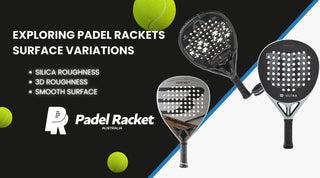Exploring Padel Racket Surface Variations: Silica Roughness, 3D Roughness, and Smooth Surface - A Focus on Differences and Durability
Introduction: In the world of padel, precision and performance are paramount, and the surface of your racket plays a pivotal role in your game. This comprehensive guide aims to unravel the nuances between three distinct racket surface textures: Silica Roughness, 3D Roughness, and Smooth Surface. Moreover, we'll delve into a crucial aspect often overlooked – the durability of these surfaces – to provide you with a holistic understanding of their impact on your game.
Silica Roughness: Enhancing Spin and Considerations of Durability
Silica roughness, easily identifiable by its textured, sandpaper-like surface, is renowned for enhancing spin and control. However, it's important to note that its durability might be comparatively shorter. The abrasive particles integrated into the racket face, while significantly improving friction for heightened spin, can lead to slightly reduced durability. The texture, while enhancing performance, might also be more susceptible to wear and tear caused by the consistent impact of the ball. Some rackets that have Silica Roughness:
- Black Crown Piton 11
- Bullpadel Vertex 3 Comfort
- Black Crown Piton Furia
- StarVie Basalto Osiris 2.0
- Volt 700 Padel Racket
3D Roughness: Less Spin but Prolonged Durability
The 3D roughness surface, characterized by its intricate combination of concave and convex shapes, offers a unique proposition. It not only facilitates spin and power but also provides a solution for durability concerns. The intricate texture design not only enhances performance attributes but also tends to distribute the stress from ball impact more uniformly across the surface. This even distribution often translates to prolonged durability, enabling players to reap performance benefits without compromising the racket's lifespan. Some rackets that have 3D Roughness:
Smooth Surface: Power Coupled with Durability
While a smooth surface is often associated with delivering raw power, its durability aspect should not be overlooked. Despite offering less friction for generating spin, its sleek nature can provide an advantage in terms of durability. The absence of intricate textures can minimize the accumulation of dirt and debris that might contribute to surface wear. Furthermore, its smoothness might offer a protective edge against scratches and nicks that could otherwise impact other racket surfaces. Some rackets that have Smooth Surface:
Selecting the Ideal Surface to Match Your Style and Durability Requirements:
When choosing a racket surface texture, it's essential to consider your playing style and durability preferences:
-
Silica Roughness: If your focus lies on spin, control, and a tactile surface, silica roughness could be your go-to choice. However, be prepared for slightly shorter durability due to the textured design.
-
3D Roughness: Opt for 3D roughness if you're seeking a balance between spin, power, and extended durability. The intricate texture not only boosts performance but also ensures a longer-lasting racket face.
-
Smooth Surface: Select a smooth surface if you're inclined towards powerful shots and prioritize a racket that maintains its appearance and durability over time.
Conclusion: In the dynamic world of padel, where finesse and strength converge, your racket's surface texture is a defining factor. The choice between silica roughness, 3D roughness, and a smooth surface not only influences your playing style but also significantly impacts the durability of your equipment. By comprehending the distinct attributes and durability considerations of each surface, you're empowered to make an informed decision that aligns with your gameplay preferences and the longevity you expect from your padel racket.



